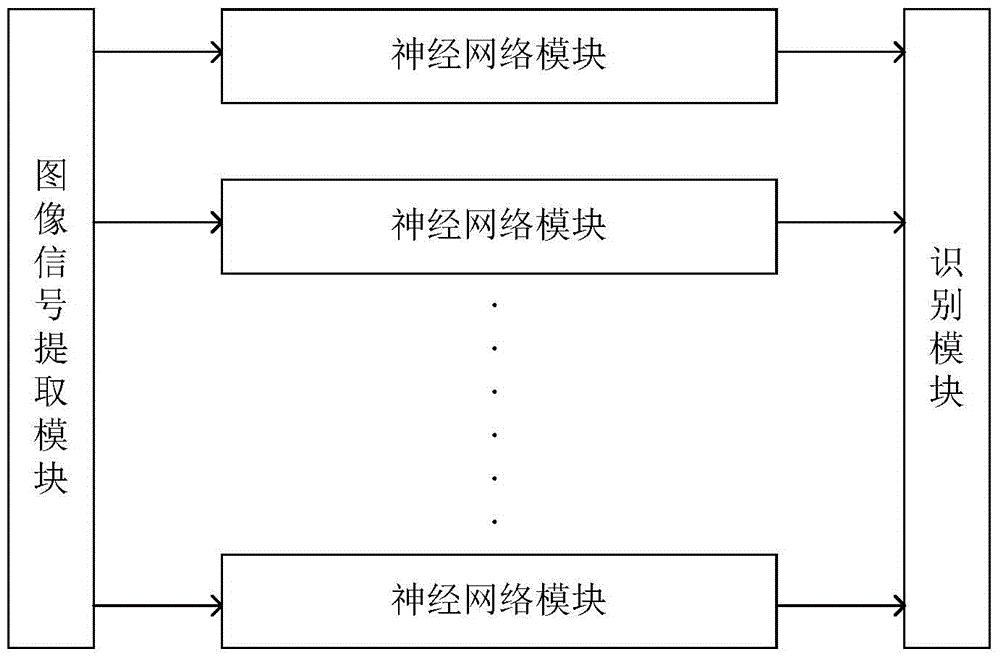A memristor-based image recognition system and method
A technology of image recognition and memristor, which is applied in the field of image recognition, can solve the problems of limited integration density, high power consumption, and poor scalability, and achieve the effects of saving time, reducing energy consumption, and lowering control costs
- Summary
- Abstract
- Description
- Claims
- Application Information
AI Technical Summary
Problems solved by technology
Method used
Image
Examples
Embodiment 1
[0068] The image recognition system based on the memristor provided by the present invention includes: an image signal extraction module, two neural network modules based on the memristor and a recognition module. The input of the recognition module is connected to the output of multiple neural network modules; the output of each neural network module is connected to the input of the recognition module, and its input is connected to the output of the signal extraction module.
[0069] The image signal extraction module is used to extract the feature vector signal of the grayscale image for training and to be recognized, and input it into the neural network module, including a host computer and 12 pulse generators. The host computer is connected with 12 pulse generators for reading grayscale image signals, extracting its eigenvectors, and delivering a plurality of eigenvalues of the eigenvectors to corresponding pulse generators respectively; the pulse generators , the input ...
Embodiment 2
[0080] The first neural network module is used to represent the image model of the number "3", and the training method is as follows:
[0081] (a) Select 5 grayscale pictures representing the number "3", such as Figure 8 (a) to (e);
[0082] (b) Feedforward stage:
[0083] The image signal extraction module reads the pixel matrix of the grayscale image for each grayscale image used for training; uses the edge function as an edge detection function to detect edge pixels in the pixel matrix, and calculates the proportion of edge pixels as edge pixels Mean value; the pixel feature matrix is divided into 3×4 blocks, and the ratio of edge pixels in each image block is compared with the mean value of edge pixels. If it exceeds the mean value of edge pixels, "1" is used as the feature value of the image block. Otherwise, "0" is used as the eigenvalue of the image block; the eigenvalues of the image block are combined into a eigenvector in the order from top to bottom between row...
Embodiment 3
[0090] The image recognition method provided by the present invention, using the image recognition system as described in Embodiment 1, specifically includes the following steps:
[0091] (1) The image signal extraction module obtains the feature vector of the grayscale image to be recognized, and transmits the feature vector to each neural network module; the specific steps for the image signal extraction module to obtain the feature vector are as in Example 2. The image signal extraction module acquires training The specific steps of using the grayscale image feature vector.
[0092] (2) After the first neural network module and the second neural network module are trained according to the method of embodiment 2, respectively represent the model of the picture representing the number "3" and the model of the picture representing the number "5"; The first neural network module and the second neural network module respectively score the feature vectors of the image to be recog...
PUM
 Login to View More
Login to View More Abstract
Description
Claims
Application Information
 Login to View More
Login to View More - R&D
- Intellectual Property
- Life Sciences
- Materials
- Tech Scout
- Unparalleled Data Quality
- Higher Quality Content
- 60% Fewer Hallucinations
Browse by: Latest US Patents, China's latest patents, Technical Efficacy Thesaurus, Application Domain, Technology Topic, Popular Technical Reports.
© 2025 PatSnap. All rights reserved.Legal|Privacy policy|Modern Slavery Act Transparency Statement|Sitemap|About US| Contact US: help@patsnap.com



